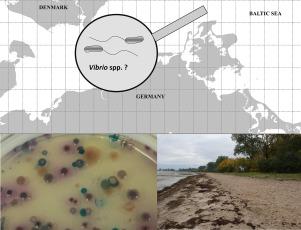Journal of Marine Systems ( IF 2.7 ) Pub Date : 2021-05-18 , DOI: 10.1016/j.jmarsys.2021.103574 Lars Möller , Bernd Kreikemeyer , Gunnar Gerdts , Günter Jost , Matthias Labrenz

|
Vibrio spp. are ubiquitous in aquatic environments. In temperate regions, including the Baltic Sea, these bacteria, which include facultative pathogenic species, proliferate during warm water periods and may thus pose a risk to human health. However, while present at relatively high abundances in the summer months, Vibrio spp. are rarely detected during cold water periods. Several potential winter reservoirs, such as fish and sediment, have been discussed, but the seeding sources that give rise to Vibrio during the summer months are unknown.
In this study, we employed a combination of cultivation-independent genus-specific digital droplet PCR, Illumina 16S rRNA gene sequencing, culture-dependent determinations of colony-forming units (CFU) and genus-specific strain isolation to identify possible winter reservoirs of Vibrio spp. Using these techniques, we demonstrate that in the southern Baltic Sea especially fish can serve as a winter reservoir for distinct Vibrio assemblages, including facultative pathogenic V. vulnificus. Particularly the invasive species round goby (Neogobius melanostomus), with its potential to appear in high individual densities, has the capacity to carry a comparable Vibrio spp. cell number like water and sediment, while only accounting for 1/1000 of the spatial share in the overall coastal environment. Thus, by providing a winter reservoir for distinct Vibrio communities, coastal fish and, especially areas in which round goby densities are high, may be hot spots of pathogenic Vibrio species.
中文翻译:

将鱼作为弧菌的冬季水库。在波罗的海南部海岸
弧菌属。在水生环境中无处不在。在包括波罗的海在内的温带地区,这些细菌(包括兼性病原体)会在暖水时期扩散,因此可能对人类健康构成威胁。然而,尽管在夏季月份出现了相对较高的丰度,但弧菌属。在冷水时期很少被发现。已经讨论了几种潜在的冬季水库,例如鱼类和沉积物,但尚不清楚在夏季月份产生弧菌的种子来源。
在这项研究中,我们结合了不依赖培养的属特异性数字液滴PCR,Illumina 16S rRNA基因测序,依赖培养物的菌落形成单位(CFU)测定和属特异性菌株分离相结合,以鉴定可能的冬季弧菌spp。使用这些技术,我们证明了在波罗的海南部,尤其是鱼类可以作为不同弧菌组合的冬季水库,包括兼性致病性弧菌。特别是具有高个体密度出现潜能的虾虎鱼(Neogobius melanostomus)入侵物种,具有携带可比拟弧菌的能力。spp。像水和沉积物这样的细胞数目,而仅占整个沿海环境中空间份额的1/1000。因此,通过为不同的弧菌社区提供冬季水库,沿海鱼类,特别是圆虾虎鱼密度高的地区,可能成为病原弧菌物种的热点。











































 京公网安备 11010802027423号
京公网安备 11010802027423号